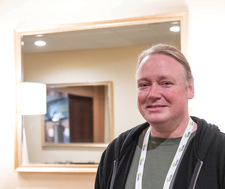An interview with Brian Behlendorf
Back on the Block

© By Swapnil Bhartiya
Apache developer, Brian Behlendorf, talks about Hyperledger and blockchains.
Brian Behlendorf is nothing short of an open source celebrity. Behlendorf was one of the primary developers of an open source project that revolutionized the web: the Apache web server. In 2003, MIT Technology Review listed Behlendorf among the top 100 innovators in the world under the age of 35.
I first met Behlendorf back in 2005, when I lived in India, and I would often seek his input for my stories. But Behlendorf took a sabbatical from the open source world for several years. Early this year, The Linux Foundation appointed Behlendorf as the executive director to head their Hyperledger project. Hyperledger, which launched in December 2105, is an industry-wide effort to develop and enhance open standards for blockchain transaction technology. Blockchain is best known as the technology at the core of the Bitcoin cryptocurrency, but many experts believe it has much wider application to a range of tasks, from banking, to medicine, to real estate.
I asked Behlendorf what he has been doing all these years – and what brought him to The Linux Foundation.
[...]
Buy this article as PDF
(incl. VAT)
Buy Linux Magazine
Subscribe to our Linux Newsletters
Find Linux and Open Source Jobs
Subscribe to our ADMIN Newsletters
Support Our Work
Linux Magazine content is made possible with support from readers like you. Please consider contributing when you’ve found an article to be beneficial.

News
-
Two New Distros Adopt Enlightenment
MX Moksha and AV Linux 25 join ranks with Bodhi Linux and embrace the Enlightenment desktop.
-
Solus Linux 4.8 Removes Python 2
Solus Linux 4.8 has been released with the latest Linux kernel, updated desktops, and a key removal.
-
Zorin OS 18 Hits over a Million Downloads
If you doubt Linux isn't gaining popularity, you only have to look at Zorin OS's download numbers.
-
TUXEDO Computers Scraps Snapdragon X1E-Based Laptop
Due to issues with a Snapdragon CPU, TUXEDO Computers has cancelled its plans to release a laptop based on this elite hardware.
-
Debian Unleashes Debian Libre Live
Debian Libre Live keeps your machine free of proprietary software.
-
Valve Announces Pending Release of Steam Machine
Shout it to the heavens: Steam Machine, powered by Linux, is set to arrive in 2026.
-
Happy Birthday, ADMIN Magazine!
ADMIN is celebrating its 15th anniversary with issue #90.
-
Another Linux Malware Discovered
Russian hackers use Hyper-V to hide malware within Linux virtual machines.
-
TUXEDO Computers Announces a New InfinityBook
TUXEDO Computers is at it again with a new InfinityBook that will meet your professional and gaming needs.
-
SUSE Dives into the Agentic AI Pool
SUSE becomes the first open source company to adopt agentic AI with SUSE Enterprise Linux 16.

